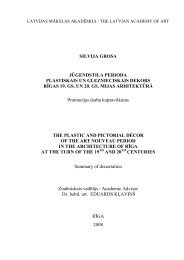Institute of Art History of the Latvian Academy of Art Anna Ancāne ...
Institute of Art History of the Latvian Academy of Art Anna Ancāne ...
Institute of Art History of the Latvian Academy of Art Anna Ancāne ...
Create successful ePaper yourself
Turn your PDF publications into a flip-book with our unique Google optimized e-Paper software.
comparable to portals at 29 Chlebnicka and 52 Piwna in Danzig as well<br />
as to Swedish portals in <strong>the</strong> 1630s and 1640s, belonged to <strong>the</strong> circle <strong>of</strong><br />
Renaissance echoes. The second trend was represented by <strong>the</strong> portal with<br />
<strong>the</strong> richest plastic décor <strong>of</strong> <strong>the</strong> time at 11 Monētu Street, but <strong>the</strong> portal at<br />
11 Dome Square (1650) manifested horror vacui typical <strong>of</strong> <strong>the</strong> 1 st half <strong>of</strong><br />
<strong>the</strong> century, comparable to <strong>the</strong> portal at 22 Piwna in Danzig. Most <strong>of</strong> <strong>the</strong><br />
portals <strong>of</strong> <strong>the</strong> 1 st half <strong>of</strong> <strong>the</strong> 17 th century feature decorative leaning.<br />
Tectonic parts were let into <strong>the</strong> overall decorative design, following<br />
Serlio’s idea <strong>of</strong> <strong>the</strong> classical order as a “raw material” for ornament.<br />
V.3.2. Portals in <strong>the</strong> 2 nd half <strong>of</strong> <strong>the</strong> 17 th century<br />
As a tendency towards classical language <strong>of</strong> forms emerged, up to <strong>the</strong><br />
1670s <strong>the</strong>re was a mixed scene <strong>of</strong> ornament in which variations <strong>of</strong><br />
scrollwork coexisted with floral and fruit ornaments. Like in Germany<br />
where <strong>the</strong> use <strong>of</strong> acanthus ornaments were top modern in <strong>the</strong> last third <strong>of</strong><br />
<strong>the</strong> 17 th century as Italian samples were reprinted, in Riga <strong>the</strong>y spread<br />
more widely in <strong>the</strong> 1680s. The 1660s and 1670s were a transitional period<br />
during which Mannerist and classical elements coexisted, but in <strong>the</strong><br />
1680s and 1690s classical elements in <strong>the</strong>ir Vitruvian version, not via<br />
Serlio’s interpretation, became predominant in portals. In <strong>the</strong> 2 nd half <strong>of</strong><br />
<strong>the</strong> 17 th century <strong>the</strong> classicising tendency took over <strong>the</strong> construction and<br />
ornamentation <strong>of</strong> portals completely. If <strong>the</strong> 1670s were a sort <strong>of</strong> “blank<br />
period”, more portals are known from <strong>the</strong> last quarter <strong>of</strong> <strong>the</strong> 17 th century:<br />
a) portals in <strong>the</strong> shape <strong>of</strong> triumph arch; b) “ornamental” or atectonic<br />
portals with flower and fruit décor; c) portals with <strong>the</strong> upper-light<br />
windows; d) tectonic or constructive portals with sculptural décor.<br />
Triumph arch-type portals<br />
This group demonstrates <strong>the</strong> most representative portals <strong>of</strong> Riga whose<br />
location and function in public or private buildings required <strong>the</strong> classical<br />
composition <strong>of</strong> triumph arch. Influences from Stockholm are evident in<br />
<strong>the</strong> strong and ra<strong>the</strong>r dry style <strong>of</strong> Riga’s fortification gate portals. On <strong>the</strong><br />
o<strong>the</strong>r hand, examples inspired by Sou<strong>the</strong>rn Baroque also emerged, with a<br />
rich sculptural and ornamental finish and detached columns, like St.<br />
Peter’s Church west-side portals. Ornament enters <strong>the</strong> mature phase <strong>of</strong><br />
acanthus – dynamic, lush leaves are complemented with putti, angels’<br />
heads, birds, etc. The genesis <strong>of</strong> this Baroque ornament is related to <strong>the</strong><br />
samples by Stefano della Bella and elaborated ornamental style <strong>of</strong> Jean<br />
Le Pautre.<br />
Secular public buildings also showed a tendency towards <strong>the</strong> richest<br />
examples, adapting variations on <strong>the</strong> triumph arch <strong>the</strong>me (portals <strong>of</strong><br />
Blackheads’ House (1699) and Orphanage (1691)). Portals <strong>of</strong> dwelling<br />
houses also could be added to <strong>the</strong> group featuring detached columns – at<br />
2 Mārstaļu Street and 1 Zirgu Street.<br />
23












